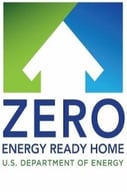 The U.S. Department of Energy (DOE) last month released the latest version of the Zero Energy Ready Home (ZERH) requirements for single-family homes. Version 2 of the ZERH requirements included an update of the thermal envelope insulation levels to those required by the 2021 Residential IECC, whereas the previous version (V1 Rev 8) stipulated 2015 IECC thermal insulation requirements. DOE also highlighted the new tax credits available to builders through the 45L builder energy efficiency tax incentive.
The U.S. Department of Energy (DOE) last month released the latest version of the Zero Energy Ready Home (ZERH) requirements for single-family homes. Version 2 of the ZERH requirements included an update of the thermal envelope insulation levels to those required by the 2021 Residential IECC, whereas the previous version (V1 Rev 8) stipulated 2015 IECC thermal insulation requirements. DOE also highlighted the new tax credits available to builders through the 45L builder energy efficiency tax incentive.
Three reasons to build ZERH
With the global focus on decarbonization, zero energy ready construction is attractive to builders and buyers for a variety of reasons. ZERH are verified by a qualified third party and are at least 40 to 50 percent more energy efficient than a typical new home. [1] With this new version of the ZERH requirements, builders have many reasons to consider constructing them. Among the top three:
- More Energy Efficient
Using the 2021 IECC as a backstop for the thermal envelope requirements means delivering an estimated energy savings of 8.8 percent across all climate zones compared to the 2015 IECC, according to the Pacific Northwest National Laboratory.[2] Cost and energy use savings are important considerations for home buyers.
- Lowering Greenhouse Gas Emissions
Increasing building energy efficiency (as ZERH V2 does) is a powerful yet underutilized tool to reduce greenhouse gas emissions and their resulting climate impacts. Several ZERH program requirements, including the 2021 ECC envelope, are designed to last, locking in operational carbon savings for years to come. With an increasing number of builders taking steps to lower operational carbon and embodied carbon as part of global decarbonization efforts, the ZERH program is a valuable guide.
- Builder Tax Credit of $5,000
Under the new, improved 45L builder incentive, homebuilders are now eligible for a tax credit for building to ENERGY STAR and ZERH standards. The ENERGY STAR credit is $2,500, and the ZERH credit is $5,000. This tax credit is available for each new home constructed to the specifications from January 1, 2024, through December 31, 2032. Builders of manufactured homes qualify for a $2,500 credit if the home is built to ENERGY STAR requirements and a $5,000 credit if built to ZERH standard. Multi-family home builders constructing homes to ENERGY STAR requirements could qualify for a tax credit of $500 that would increase five-fold to $2,500 if prevailing wage requirements are met. If a multi-family home is constructed with ZERH requirements, the tax credit would be $1,000 and would increase to $5,000 if the prevailing wage requirement is met.
Conclusion
There’s lots of guidance available to builders interested in ZERH construction. However, the best place to start is with the DOE ZERH website, which is a wealth of information for builders and potential home buyers. It also provides detailed information on the 45L builder tax incentives available.
[1] https://www.eeba.org/zero-energy-ready-homes-what-does-it-mean-to-be-future-ready#:~:text=DOE%20Zero%20Energy%20Ready%20Homes,than%20a%20typical%20new%20home.
[2] https://www.energycodes.gov/sites/default/files/2021-12/ColoradoResidentialCostEffectiveness_2021.pdf





